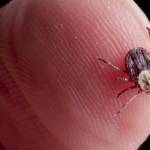Where Do Ticks Stick on Your Horse?

If you live in a region rife with ticks, chances are good that your horse has played host to its fair share of these bloodsuckers. Researchers in the southwest U.S. recently set out to determine the seasonality of tick infestations and attachment site preferences in horses.*
Researchers in the Department of Veterinary Pathobiology at the Oklahoma State University College of Veterinary Medicine chose 88 horses of varying ages from eight different farms for this study. Every horse was inspected thoroughly for ticks twice each month for 12 consecutive months. All ticks were identified as to species and stage of life, and attachment sites of ticks were recorded.
One or more ticks were found on 74 of the 88 horses throughout the duration of the study. A total of 2,731 ticks were collected during the year. Five tick species were identified, with the most prevalent being Amblyomma americanum, known commonly as lone star, northeastern water, or turkey ticks. Of all the ticks collected, 78% (2,136) were lone star ticks, which are indigenous to much of the United States east of central Nebraska, Oklahoma, and Texas. Ticks of this species bite painlessly and remain attached to their hosts until they are fully engorged with blood, up to seven days. In this study, lone star ticks were most often found in the inguinal area, or just in front of the sheath or udder.
The second most abundant species of tick discovered on horses in this study was Ixodes scapularis, also known as the deer tick or black-legged tick. Researchers pulled nearly 500 of these ticks from the horses, primarily from the chest region. These ticks rank high among problematic ectoparasites of horses for a single reason: they are vectors for Borrelia burgdorferi, the bacterium that causes Lyme disease.
While the largest number of ticks were found in May, ticks were found on horses every month of the year, including during the winter.
What are the best ways to limit the number of ticks on your horse?
- Physical monitoring. Everyday grooming is the easiest of all prevention strategies, paying special attention to areas where ticks like to attach, including the chest, between the front legs, on the abdominal midline, and in the forelock, mane, and tail. All ticks should be removed from the horse and disposed of, not released back into the environment.
- Use tick repellants. Efficacy and duration of action depends largely on the ingredients. Some are sprays, others are spot-on or pour-on products. Various factors will limit effectiveness of these products, such as sweat, precipitation, and bathing frequency, so regular reapplication may be necessary for optimal effectiveness.
- Survey turnout areas. While environmental control may have a negligible effect on the reduction of the native tick population, careful management of vegetation in areas accessible to horses might help, including quickly removing fallen limbs or trees and mowing pasture frequently to avoid tall grasses.
- Discourage deer and other wildlife. Certain wildlife can increase tick populations in pastures and neighboring woodlands. For example, turkeys are well-known hosts for lone star ticks, and deer frequently harbor black-legged ticks. While it might be impossible to keep wildlife away from all turnout areas, it would be best to discourage their presence by not feeding them or providing special habitat for them.
*Sundstrom, K.D., M.W. Lineberry, A.N. Grant, K.T. Duncan, M.M. Ientile, and S.E. Little. 2021. Equine attachment site preferences and seasonality of common North American ticks: Amblyomma americanum, Dermacentor albipictus, and Ixodes scapularis. Parasites and Vectors:s13071-021-04927-8.








